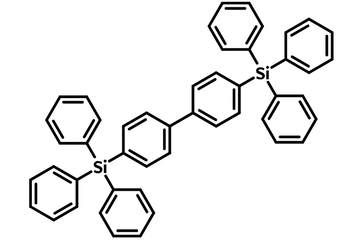BSB
CAS Number 18826-13-6
Electron Transport Layer Materials, High Purity Sublimed Materials, Host Materials, Materials,BSB, phosphorescent host for blue light-emitting materials
Used to improve device performance of OLEDs, 4,4'-di(triphenylsilyl)-biphenyl, Sublimed ≥99.0%, CAS No. 18826-13-6
BSB, 4,4'-di(triphenylsilyl)-biphenyl, has a structure of two triphenyllsilanes joined by a biphenyl spacer. The other family member, UGH-2, has a phenyl spacer.
Having a deep HOMO energy level and a wide bandgap, BSB is normally used as phosphorescent host for blue light-emitting materials such as FIrPic. When compared to UGH-2, it has higher glass transition temperature (Tg = 100 °C) to afford better morphology of OLED device films for higher device performance and stability. Electroluminescence devices using FIrpic as the blue phosphorescence dopant and UGH2, BSB, and BST (4,4″-bis(triphenylsilanyl)-(1,1′,4′,1″)-terphenyl) as the hosts show that BSB provides best device performance.
General Information
| CAS number | 18826-13-6 |
|---|---|
| Chemical formula | C48H38Si2 |
| Molecular weight | 670.99 g/mol |
| Absorption | λmax 271 nm (dichloromethane) |
| Photoluminescence | λem 432 nm (dichloromethane) |
| HOMO/LUMO | HOMO = 6.5 eV, LUMO = 2.3 eV; ET = 2.76 eV [1] |
| Chemical name | 4,4'-Di(triphenylsilyl)-biphenyl |
| Synonyms | 4,4'-bis-triphenylsilanyl-biphenyl, 4,4'-di(triphenylsilyl)-biphenyl |
| Classification / Family | Arylsilane derivatives, Phosphorescent host materials, Electron transport materials, Hole blocking layer materials, Sublimed materials, Semiconducting small molecules |
Product Details
| Purity | Sublimed >99.0% (HPLC) |
|---|---|
| Melting point | Tg = 100 °C (lit.) |
| Appearance | White powder/crystals |
*Sublimation is a technique used to obtain ultra pure-grade chemicals. For more details about sublimation, please refer to the sublimed materials.
Chemical Structure

Device Structure(s)
| Device structure | ITO (125 nm)/PEDOT:PSS (35 nm)/CBP:16 wt% FIrpic (10 nm)]/BSB:Spiro-2CBP (3 nm)/Spiro-2CBP:4wt % Ir(2-phq)3 (5 nm)/TPBi (32 nm)/LiF (1 nm)/Al (150 nm) [2] |
|---|---|
| Color |
|
| EQE @ 100 cd/m2 | 22.7% |
| Current Efficiency @ 100 cd/m2 | 53.8 cd/A |
| Power Efficiency @ 100 cd/m2 | 36.0 Im/W |
| Device structure | ITO (125 nm)/PEDOT:PSS (35 nm)/CBP (10 nm)]/BSB:Spiro-2CBP (3 nm)/Spiro-2CBP:4wt % Ir(2-phq)3 (5 nm)/TPBi (32 nm)/LiF (1 nm)/Al (150 nm) [2] |
|---|---|
| Color |
|
| EQE @ 100 cd/m2 | 17.2% |
| Current Efficiency @ 100 cd/m2 | 36.2 cd/A |
| Power Efficiency @ 100 cd/m2 | 28.6 Im/W |
MSDS Documentation
Literature and Reviews
- Interlayer Engineering with Different Host Material Properties in Blue Phosphorescent Organic Light-Emitting Diodes, J. Lee et al., ETRI J., 33 (1), 32-38 (2011); DOI: 10.4218/etrij.11.0110.0172.
- High Efficiency Very Low Color Temperature Phosphorescent Organic Light Emitting Diodes, S. Kumar et al., IPCSIT, 28, 117-121 (2012).
- White Organic Light-Emitting Diodes Utilized by Near UV-Deep Blue Emitter and Exciplex Emission, Y. Park et al., J. Nanosci. Nanotechnol., 11 (2); 1381–1384 (2011); DOI: 10.1166/jnn.2011.3376.
